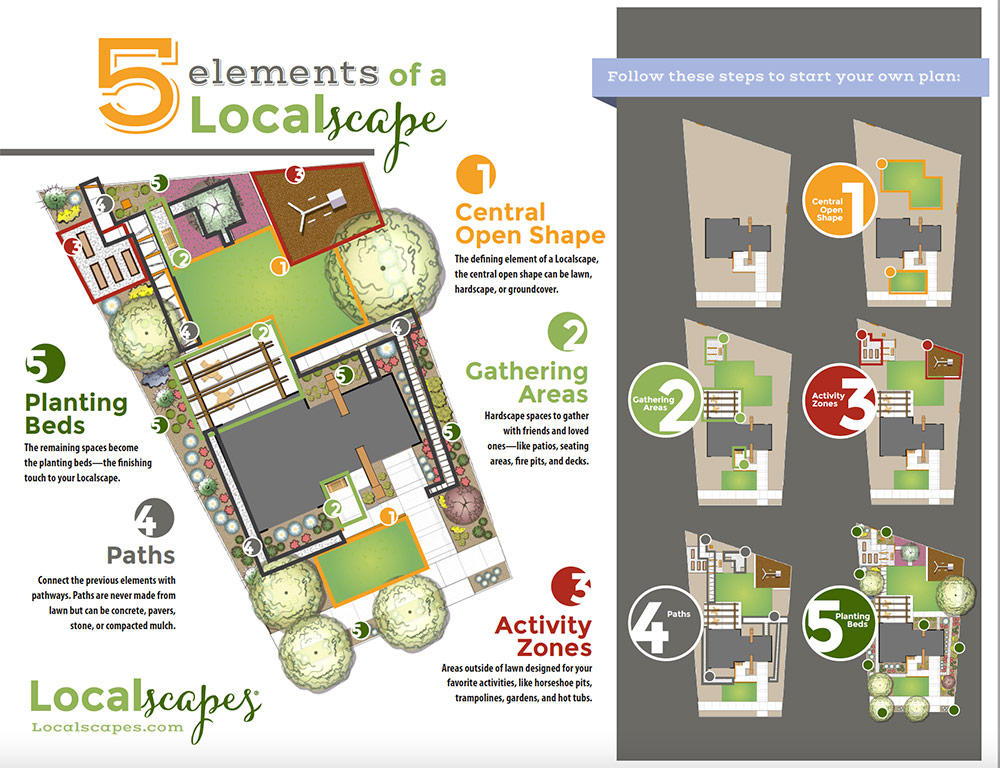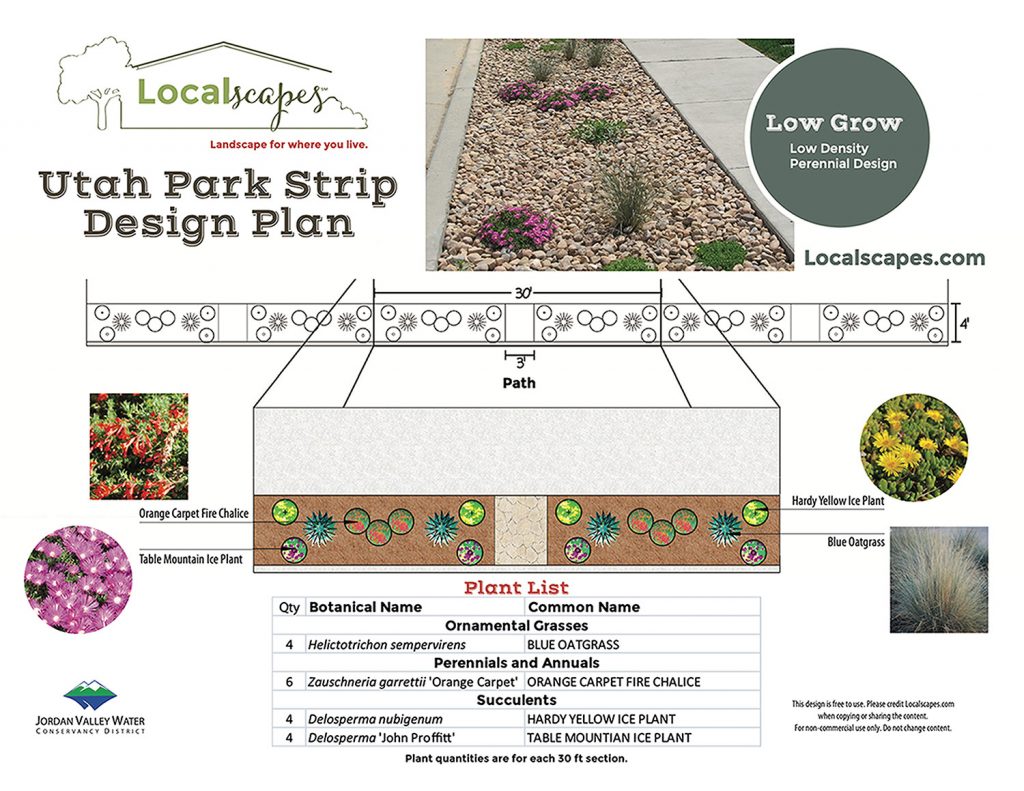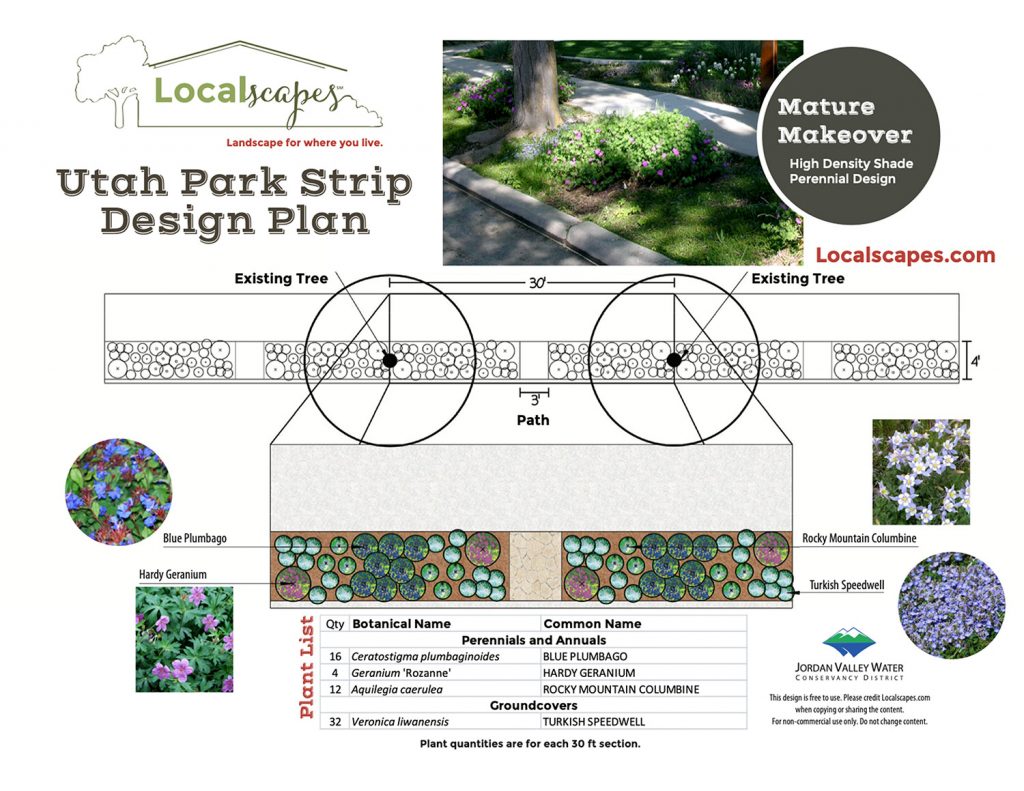Localscapes®: How Utah Is Building Buy-in for Waterwise Landscapes
And Utah homeowners are getting their dream yards!
By Ann Kendall
How do you get homeowners excited about waterwise landscaping? It’s a question many of us are wrestling with as our western population grows and water supplies become more limited.
Look to Utah for inspiration with their rapidly-growing landscape solution called Localscapes®. Localscapes is a five-step method that helps homeowners create their ideal Utah yards.
Interestingly, you’ll rarely hear water savings discussed in their messaging, but these Utah landscapes are likely saving a significant amount of water. When homeowners reduce non-functional parts of their traditional lawns, water more efficiently, and embrace waterwise plants like those from Plant Select, they could reduce their water use by 50 percent or more.

(Image used with permission)
It all started in 2014
“The big ah-ha for us came out of a focus group in 2014,” shares Cynthia Bee, a sustainable landscapes expert and the outreach coordinator for the Jordan Valley Water Conservancy District in northern Utah.
Cynthia and her colleagues could see that Utah homeowners were changing their yards, but they weren’t changing them to water-efficient landscapes, despite living in the high desert.
The water district wanted to find out why, so they hired an outside company to help them with focus groups and discovery.
The key message they heard loud and clear is that homeowners equated conservation with sacrifice. As one participant shared to many nodding heads, “I’m giving up something of greater value [my lawn] for something of lesser value [water conservation].”
For Cynthia and her team, this gave them a giant clue.
They were approaching things backwards, emphasizing water conservation as the problem.
Instead, they needed a landscape solution that tapped into the motivations their local homeowners already had—like a desire for better curb appeal, lower maintenance and more quality time with family—but in a way that produced water savings as one of the outcomes.
“We all have different values,” Cynthia observes, “so we need to change how we talk about our solution.
“If the thing that gets people moving is they’ll have a better-looking yard, they’re still saving water. It’s still a win.”
Creating a uniquely Utah solution
While the Utah team drew inspiration from Colorado’s xeriscape principles, they focused on developing an actionable solution that’s unique to Utah residents.
For example, it’s a xeric best practice to limit areas of lawn, but what does that mean exactly? How much lawn?
In Localscapes, it’s clearly defined.
To count as a Localscape in northern Utah, residents can have up to 35% lawn in their front yard and up to 35% in their back yard. And it needs to be in a single, central open shape—ideal for outdoor recreation and watering efficiency. (In southern Utah where the growing conditions are more like Arizona’s, they have their own set of local criteria.)
The team also wanted Localscapes to be practical.
Typically, people don’t like dramatic change. They’re unlikely to go from having a full lawn to a no-lawn landscape. And even if they do, most homeowners don’t have the skillset to maintain it, which means it may turn into an eyesore or a headache. Now you’ve turned off 100 neighbors!
The Utah team focused on creating a landscape solution that scales in a slower way. It’s a solution that’s similar to what homeowners already have, but it looks better and is more practical.
“Your outcomes have to be fairly familiar to people,” Cynthia explains. “Every Maroon 5 song sounds the same—but a little different. People gravitate to the familiar. They want just enough nuance to be new.”
The solution also had to be simple: What’s the least amount of action that needs to be taken to get the ideal result?
The team invited representatives from the full spectrum of skillsets to one table: landscape design, construction, horticulture, water use, irrigation, landscape maintenance and marketing.
Together, they defined the key things that Utah homeowners need to know, so the Localscapes approach feels simple and doable.
“Simplicity is the hardest thing to deliver,” says Cynthia, “But you can always give people more information as they’re ready for it.”
One of their best practices is to make the landscape process visual. It’s easy to sum up on a one-page piece of paper. (If you can’t boil it down, there’s still work to be done!)
Another best practice is to involve marketing people from the beginning. It can’t just be an academic solution.
Cynthia knows there was logic and good intention behind the word, ‘xeriscape,’ but she notes: “A marketing person will look at that word and say, ‘It sounds like ‘zeroscape.’ That’s not going to work.”
Thinking about landscapes in pieces
It would be awesome if homeowners could start with a blank slate and renovate their entire landscapes at once. But in Utah, the reality is that only about 10% of homeowners are starting fresh.
Most are retrofitting an existing landscape one piece at a time.
With that in mind, Localscapes emphasizes starting with Flip Your Strip®—a landscape solution for that tough-to-keep-alive strip of lawn between the sidewalk and the street. (In Utah, they refer to it as a “park strip.”)
Flip Your Strip teaches homeowners how to turn their park strips into beautiful, water-efficient islands of plants.


Cynthia notes, “It’s a great first step for people because they aren’t emotionally attached to the park strip. No one’s telling their kids to go play on that piece of lawn. It’s a small, contained area that’s easy to imagine, and it gives homeowners practical application of all the stuff we’ve taught them.”
The park strip is the gateway to a beautiful (and more water efficient) landscape. It’s easy to show the value of it. And when people see how well it turns out and how easy it is to maintain, they’re more eager to tackle other parts of their yard—even spaces where there’s more emotional attachment, like backyards.
Park strips also get a lot of attention.
Cynthia says they’ve had homeowners report that their neighbors have started out saying, “You’re going to be sorry you’re doing that!”, but as the new park strips take shape, all the neighbors want to do it too.
Creating a solution that can scale
Back in 2015, the Localscapes team realized it wasn’t sustainable to teach each homeowner individually. Instead, they invested in creating online learning, so homeowners can efficiently watch classes and learn landscaping techniques at any time.
To supplement online learning, homeowners also can find other helpful resources—whether they prefer in-person classes, simple YouTube videos, a Facebook work group, or a hands-on demonstration garden at Conservation Garden Park in West Jordan, Utah.
(The latter is an award-winning Plant Select Demonstration Garden.)
Initially, the demonstration garden was conceptual and artistic. But the team quickly learned that it had to contain practical examples. Homeowners wanted to see exactly how a Localscape could look with yard demonstrations that were to scale.
The team also has partnered with organizations like Parade of Homes to install Localscapes outside new construction homes. The yards give homeowners real-life examples and inspiration. Plus, the new landscapes meet the water efficiency standards that Utah has set on all new construction.
“Early on, we did one of our first Localscapes at a Parade of Homes, and attendees said, ‘We wish our yards looked more like this,’” Cynthia says. “We knew we’d hit the mark.”
Pairing Localscapes with incentives
Utah’s major water utilities offer Localscapes rebate programs for homeowners across Utah. (Approximately 86% of Utah’s residents live in four water districts.)
Localscapes Rewards is based on meeting the criteria for a Localscape, and it rewards residents for achieving water savings. Residents upload their water bill through a central source—UtahWaterSavers.org—to find all the rebate programs that apply to them.
One of Utah’s best practices has been to keep the rebate programs separate from the landscaping solution. When people want to learn how to create their dream Utah landscape, they go to Localscapes. When they want rebates, that’s Utah Water Savers.
Homeowners know exactly where to go to find what they need. Because all entities (from cities to water districts) offer Utah-specific rebates through one source—Utah Water Savers—there’s less confusion and fewer barriers to participation.
Plus, it’s easier to market.
Not to mention, rebates are constantly changing. There’s some natural trial and error. By keeping the entities separate, there’s the ability to make changes without having a dramatic effect on the other.
Landscape professionals win in this too
It’s natural to think that sharing a do-it-yourself landscaping solution with the public could be detrimental for landscape professionals. But the Localscapes approach has had the opposite effect. It’s created a boom of business for the landscape industry in Utah.
There are some homeowners who do a great job of applying the five steps of Localscapes on their own. And there are others who can’t do it themselves and have no qualms about hiring a designer to help them.
Because these homeowners have gone through the Localscapes training, it’s easier for them to communicate with their designer. They have context to what goes into a landscape and how much it costs. They’re much better qualified, and they tend to be better clients.
Localscapes’ participation is continually increasing
Participation has been growing exponentially. In 2022, 659 participants qualified for the Flip Your Strip rebate (a big jump from 2021). In 2022, 190 participants qualified for the Localscapes Rewards rebate.
Looking ahead to 2023, the team is anticipating more growth across the state, particularly as the State of Utah gets ready to add to new rebates and incentive programs.
Amanda Stack, the conservation supervisor for the Jordan Valley Water Conservancy District, keeps track of homeowner progress.
She says she enjoys watching people make the transformation from feeling intimidated by their landscapes, to realizing they can excel at landscaping, to successfully creating gorgeous yards.
During the process, homeowners are discovering the beauty of waterwise plants.
People are “learning a whole new plant palette,” Amanda shares. “I recently had one homeowner say, ‘I’d never even looked at waterwise plants before, and they’re so beautiful.’”
So, can Localscapes be used outside of Utah?
Cynthia says they’re often asked whether Localscapes can be used in other places. While the team is happy to teach others the process of how to create a local or regional landscaping solution, Localscapes is a brand that’s all their own.
They’ve seen what’s happened to Colorado xeriscapes.
Xeriscapes were innovative at the time they were introduced, but then the concept was borrowed and altered, turning into something that’s often misunderstood.
(Hello, rock zeroscapes!)
“We’re happy to teach others how to create their own solutions, but part of the power of the solution is that it’s just for locals,” Cynthia shares.
“Localscapes is a design style for us. We’ve localized it to different parts of our state. Southern Utah uses different plants and materials and slightly less lawn than northern Utah.
“And the key is to get all your experts in one room—a team that’s been nominated—and get them to say, ‘This is the solution. This is easy to design and maintain where we live.’
“The more you can learn about your local audience and the more you can show you understand the subtleties and personality of your area, the more you’re going to build confidence in your solution.”
Inspiring people to see their landscapes differently
Cynthia equates waterwise landscaping to weight loss.
Yes, it’s important for people to improve their overall health, but for many people, the real motivation is wanting to look great in a pair of jeans.
You have to understand and address the core motivation for change.
A key to success for Localscapes has been solving the real problems that people have. Utah residents are getting their dream landscapes. Along the way, they’re learning how to see their landscapes differently and dramatically cutting their water use.
It’s a win for all.
Where to learn more about Localscapes
Plant Select is proud to be an official Localscapes Partner.
To learn more about Localscapes:
- Watch Cynthia Bee’s 10-minute TedX Talk on Localscapes
- Visit the Localscapes website
- Visit the Utah WaterSavers website
Cynthia Bee is scheduled to speak at the Plant Select Annual Conference in June 2023. We hope to see you there!
Our thanks to Cynthia Bee and Amanda Stack of the Jordan Valley Water Conservancy District for their insights for this article.

